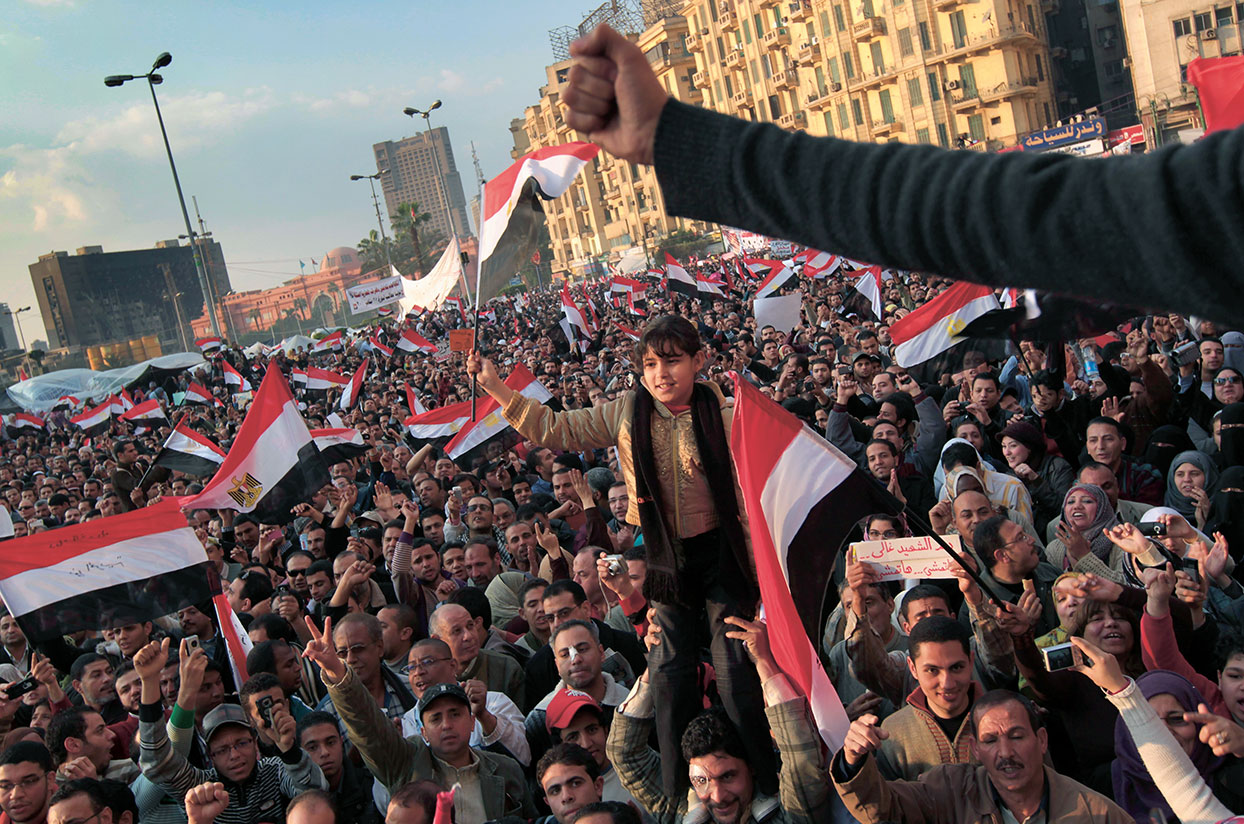Social Media and the Mobilization of the Masses
May 9, 2011column,
‘The city was a fused group’ – so says Jean-Paul Sartre, speaking of Paris during the 1789 storming of the Bastille. What Sartre apprehends in his analysis of this revolutionary moment is the necessary interdependency of space, time, movement and will. His concept of the fused group brings these elements together in a way that recognizes the capacity to transform the given into something altogether new. In the moment of fusion Sartre sees a transformation from an isolated seriality, in which each person is a lonely powerless unit, into a collective entity – a being together in the most powerful sense of the term, a mutual recognition of that which he understands as most human, freedom.

If ever such a moment has been witnessed in recent history, the revolution sparked by the 25 January movement in Egypt must surely be a candidate – producing a rupture with a seriality of domination so profound there was not time to name it, to figure out what it meant – it was an event in the truest sense of the term. But it was not an event born of an inevitable historical progression or natural catastrophe, but of the force of combined will. The question that presents itself is: How did this will come to exist and how was it so forcefully imposed?
One must recognize that this was in the first instance a moment of negativity – a reaction against a despised regime – a condemnation that propagated solidarity. This is important in the process of ‘fusion’, which is a reaction against, and overcoming of, the inert weight of the given world. But this is not enough in itself and the danger of new containment and new forms of isolation always appear on the horizon. Here the capacity to think together, to recombine and to move – to splice space into the becoming of time – is primary, which means to act: to mobilize.
It is the role of social media in the recent waves of mobilization that has caught the imagination of the West, no doubt in some measure because of our firsthand familiarity with the most widely known web platforms, ‘Facebook’ and ‘Twitter’, and their increasing centrality in everyday social life, but not without further justifications.
While global communication networks expanded in the 1990s, in the context of a burgeoning information economy the key question for activists was always: Can this network support resistance? The answer is that spread of Capital over the globe has been matched by the interconnection of civil society, piggybacking on the global infrastructure to quietly build networks of mutual recognition within and across borders, as well as between struggles. This was first seen in the global response to the rebellion of the Zapatistas in Mexico, it was used by the World Social Forum to interlink movements from around the world. This is not to say these networks are the cause of resistance movements, but they do provide the capacity, the space and opportunity to coordinate horizontally beyond the constraints of immediacy. The Internet’s distributed and scale-free topology, in combination with mobile Internet-enabled devices, enables the organization of action on the fly and a meshing of the space of the ‘real’ and the ‘virtual’, thus opening up a new front for activism.
On Tahrir Square this dynamic was most clearly apparent, ‘Tahrir square is on fire, every inch of cement is covered with people chanting “Leave” “Invalid” Mubarak’ tweeted Gsquare86, AKA, Gigi Ibrahim on 10 February. For several days it was to Tahrir Square that all eyes turned and bodies flowed, the usual patterns of media coverage, with its attempts to manage space and time with a familiar narrative arc and a unified perspective, was disrupted by the very jaggedness of the unfolding of the events. 24-hour news channels took the square’s CCTV feed, tapping into fragments of the voices from social media, trying hopelessly to capture the velocity of movement. Such disruption was a manifestation of a constituent power no longer subject to such standard forms; it was what Henri Lefebvre has described as an appropriation of space. But in the network age space is not merely three-dimensional, in relation to a linear time, but rather manifold, what Manuel Castells calls a ‘space of flows’ and interlaced with a ‘timeless time’ which multiplies the capacity for fusion, not into a single entity as Sartre defined it, but a coordinated multitude. The square was transformed into a space of resistance; of chanting in unison, tweeting, messaging – and all the while Al Jazeera, CNN and the rest fed back images in real time. This feedback loop, weaving place, space, voice and image into a mosaic, meant the moment was witnessed, shared and shaped like few before it. So it is that the concept of the fused group, while only a rough tool to hand, does open up this mobilization to imagination as one of recombination and fusion, not just of the Egyptian people, but of the peoples of the region and the world.
Cairo, 8 February 2011. Anti-Mubarak protesters continue to occupy Tahrir square. Photo: John Moore, Getty Images
References
- Manuel Castells, The Rise of the Network Society (Oxford: Blackwell, 1997)
- Henri Lefebvre, The Production of Space (Oxford: Blackwell, 1991)
- Jean Paul Sartre, The Critique of Dialectical Reason Vol. 1 (London: Verso, 1976), p. 358
Joss Hands is the author of @ is for Activism: Dissent, Resistance and Rebellion in a Digital Culture (2010). He teaches media and communication at Anglia Ruskin University, Cambridge where he is also co-director of the Anglia Research Centre in Digital Culture.